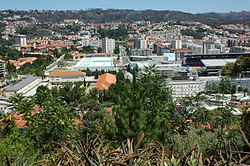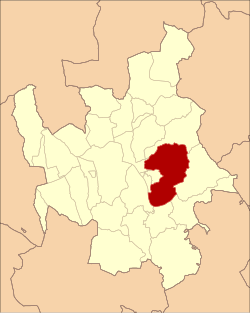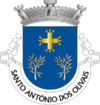Santo António dos Olivais
| Santo António dos Olivais | ||
|---|---|---|
| Civil parish | ||

The residential area Solum
|
||
|
||
 |
||
| Coordinates: 40°13′05″N 8°24′14″W / 40.218°N 8.404°WCoordinates: 40°13′05″N 8°24′14″W / 40.218°N 8.404°W | ||
| Country | Portugal | |
| Region | Centro | |
| Subregion | Baixo Mondego | |
| Intermunic. comm. | Região de Coimbra | |
| District | Coimbra | |
| Municipality | Coimbra | |
| Area | ||
| • Total | 19.27 km2 (7.44 sq mi) | |
| Elevation | 69 m (226 ft) | |
| Population (2011) | ||
| • Total | 38,936 | |
| • Density | 2,000/km2 (5,200/sq mi) | |
| Postal code | 3000 | |
| Area code | 239 | |
| Patron | Santo António | |
| Website | http://www.jfsao.pt | |
Santo António dos Olivais, commonly shortened to Olivais, is an urban civil parish in the municipality of Coimbra in Portugal, making up the eastern part of the historic city of Coimbra, east of University Hill. The population in 2011 was 38,936, in an area of 19.27 km². It is the most populated parish in the Municipality of Coimbra, and among the most densely inhabited in the country outside of Lisbon and Porto metropolitan areas. Created in 1836, the parish was named for Anthony of Padua (1195 – 1231), who joined the local branch of the Order of Friars Minor; Anthony took his name from Saint Anthony the Great, to whom the local Franciscan hermitage was dedicated.
Even by 1064, before the creation of the Kingdom of Portugal (1143), the region of Olivais was pasturelands interspersed by parcels where the local settlers cultivated vineyards and olive orchards, in addition to vegetable gardens and fruit trees, while the remaining lands were still forested (such Malheiros, Tovins, Picoto, Dianteiro and Rocha Nova).
The beginnings of the parish occurred in the 13th century (around 1210), when D. Sancha (daughter of King Sancho I) founded the Royal Monastery of Santa Maria de Celas, in the locality of Vimarães, under administration of friars of the Order of Saint Bernard. The establishment of the monastery in Vimarães was basis for the founding of the parish of Celas.
A few years later (between 1217 and 1218), Queen Urraca (wife of Afonso II) donated a small chapel on a hill of olive groves to the first Franciscan monks arriving into Portugal, which they transformed into a humble hermitage dedicated to Saint Anthony the Great. Around 1220, friar Fernando de Bulhões after taking religious orders at the Augustinian Monastery of Santa Cruz (Coimbra) joined the humble Franciscans monks, adopting the name of the small chapel's patron. After his death (1231 in the Italian town of Padua), he was canonized almost immediately, and the Franciscan convent that flourished in Olivais quickly changed its patron from Saint Anthony the Great to Anthony of Padua, becoming known as Santo António de Olivais and attracting new settlers into the region. By 1247, the Convent of São Francisco da Ponte attracted many friars, resulting in the late 15th century delimitation of the churchyard and convent in the 16th century.
...
Wikipedia

